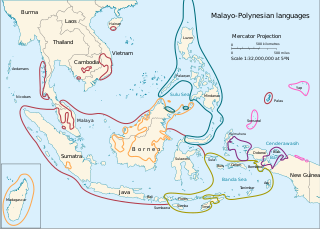
The Malayo-Polynesian languages are a subgroup of the Austronesian languages, with approximately 385.5 million speakers. The Malayo-Polynesian languages are spoken by the Austronesian people of the island nations of Southeast Asia and the Pacific Ocean, with a smaller number in continental Asia, going well into the Malay peninsula. Cambodia and Vietnam serve as the northwest geographic outlier. On the northernmost geographical outlier does not pass beyond the north of Pattani, which is located in southern Thailand. Malagasy is spoken in the island of Madagascar located off the eastern coast of Africa in the Indian Ocean. Part of the language family shows a strong influence of Sanskrit and Arabic as the western part of the region has been a stronghold of Hinduism, Buddhism and, later, Islam.

The Borneo–Philippines languages are a paraphyletic group of the Austronesian languages which includes the languages of the Philippines, much of Borneo, the northern peninsula of Sulawesi, and Madagascar. They can be divided into the Bornean languages and the Philippine languages.
The Chamic languages, also known as Aceh–Chamic and Achinese–Chamic, are a group of ten languages spoken in Aceh and in parts of Cambodia, Vietnam and Hainan, China. The Chamic languages are a subgroup of Malayo-Sumbawan languages in the Austronesian family. The ancestor of this subfamily, proto-Chamic, is associated with the Sa Huỳnh culture, its speakers arriving in what is now Vietnam from Borneo or perhaps the Malay Peninsula.
Melanau is an Austronesian language spoken in the coastal area of the Rajang delta on northwest Borneo, Sarawak, Malaysia and Brunei. There are several dialects—Mukah-Oya, Balingian, Bruit, Dalat, Igan, Sarikei, Segahan, Prehan, Segalang, and Siteng.
The East Barito languages are a group of a dozen Dayak (Austronesian) languages of Borneo, and most famously Malagasy, the national language of Madagascar. They are named after the Barito River.
The Kayan or Kayan–Murik languages are a group of Austronesian languages spoken in Borneo by the Kayan, Punan, and related peoples.
The Barito languages are around twenty Dayak (Austronesian) languages of Borneo, Southern Philippines, plus Malagasy, the national language of Madagascar. They are named after the Barito River.
The West Barito languages are a group of half a dozen Dayak (Austronesian) languages of Borneo. They are named after the Barito River.
The Mahakam or Barito-Mahakam languages are a couple of closely related Dayak (Austronesian) languages of Borneo:
The Sabahan languages are a group of Austronesian languages centered on the Bornean province of Sabah.

The Tsouic languages are three Formosan languages, Tsou proper and the Southern languages Kanakanabu and Saaroa. The Southern Tsouic languages of Kanakanabu and Saaroa have the smallest phonemic inventories out of all the Formosan languages, with each language having only 13 consonants and 4 vowels. These two languages are highly endangered, as many Southern Tsouic speakers are shifting to Bunun and Mandarin Chinese.
Ma'anyan or Ma'anjan or Maanyak Dayak is an Austronesian language belonging to the East Barito languages. It is spoken by about 150,000 Ma'anyan people living in the central Kalimantan, Indonesia. It is closely related to the Malagasy language spoken in Madagascar. There is high lexical similarity with other East Barito languages like Paku (77%) or Dusun Witu (75%).
Lawangan is an Austronesian language of the East Barito group. It is spoken by about 100,000 Lawangan people living in the central Kalimantan, Indonesia. Lawangan has a high degree of dialectal diversity.
Kayan is a dialect cluster spoken by the Kayan people of Borneo. It is a cluster of closely related dialects with limited mutual intelligibility, and is itself part of the Kayan-Murik group of Austronesian languages.
Daro and Matu are dialects of an Austronesian language spoken in Sarawak, Borneo. Gandamatu is the best dialects of Meranau lives in Sarawak.
Keninjal is a Malayic Dayak language of Borneo. Glottolog clasifies Keninjal as a Western Malayic Dayak language alongside Kendayan, but Smith (2017) includes it in the Ibanic branch of Malayic based on phonological evidence.







